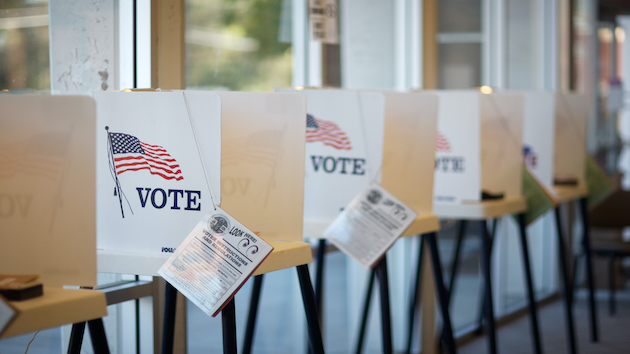(LOS ANGELES) — Efforts to combat misinformation intensified on Twitter during the days leading up to Tuesday’s recall election to replace California Gov. Gavin Newsom, who appears to have retained his gubernatorial seat, according to an ABC News projection of the election results.
Since the 2020 presidential election, there’s been more awareness of the damaging effects of the spread of misinformation on social media with fears that increasing numbers of people are engaging with false content.
The Los Angeles County Registrar-Recorder/County Clerk, which provides record management and election services, said it took to Twitter to counter misleading information and provide context to viral posts leading up to the recall election. The department said it also used Twitter to clear up confusion over casting ballots, ballot status and the color of ballot boxes.
For example: in response to a viral photo reposted on Twitter showing an election worker wearing a “Trump 2020” hat and shirt, the department clarified on Tuesday that the person was later contacted and was “no longer working at the vote center.” The photo racked up more than 34,000 likes and more than 8,000 retweets by Thursday, according to statistics on the post, with some Twitter users debating the legality of an election worker wearing political clothing.
The department’s response also garnered notable engagement on Twitter and was referenced by other users, further spreading the update that the department removed the worker.
Mike Sanchez, spokesperson for the LA County Registrar-Recorder/County Clerk, said the worker broke the department’s internal policy requiring nonpartisan clothing for employees, adding that the worker was released after he refused to change.
First Draft director Claire Wardle said the department’s Twitter activity was “a very good sign” that organizations are making an effort to combat misinformation, even before it goes viral.
First Draft is an organization that describes itself as working to “protect communities from harmful misinformation” through knowledge, research and training.
Wardle said the department took an approach known as “prebunking,” which includes correcting false claims, answering questions early on and providing explanations.
“All of that is helping people get a much better sense about what to trust and what not to trust,” Wardle said.
Wardle said an important part of the process is to give context to posts that may not be fake, but could still be misleading and damaging.
On the weekend before the recall election, the department said it fielded numerous questions after an “equipment issue” reportedly caused some voters to have trouble casting their ballots.
Throughout the weekend, the department posted on Twitter that voters who encountered the issue were given provisional ballots and that the equipment was replaced. The department’s repeated reinforcement of accurate information may have helped resolve confusion on the issue, it says, preventing it from spiraling into full-fledged falsehoods.
Conservative radio host Larry Elder, the frontrunner to replace Newsom if recalled, made unsubstantiated claims of possible voter fraud during the recall election, saying there could be “shenanigans” similar to some unsubstantiated claims of a rigged 2020 presidential election.
The country clerk, in real-time on social media, addressed concerns or questions pertaining to the recall election, arguably helping to ward off their evolving into a misinformation wildfire spreading through the internet. The department said in one instance, it answered a Twitter user’s question about the equipment issue within five minutes. Other responses came several hours later or the next day.
Sanchez, in addition to being a spokesperson, led the team that monitored social media platforms during the recall election. He said while the majority of posts were general voting inquiries, the team took action when it identified misleading and inaccurate information.
“We provide resources and try to quell those who are aiming to mislead or misguide and — or in some cases interfere — with the election and the information that goes along with obviously educating voters,” Sanchez said.
Sanchez said the department has been actively monitoring and engaging with social media for years, including during the 2020 presidential election. Last year, the department was countering misinformation about ballots, he said, and even calming fears about fire alarms.
“These
Twitter has made strong statements against election misinformation on its platform and has implemented a labeling policy. “However, the volume and speed at which misinformation has the potential to spread online means that this alone is not enough. Twitter said in January that it was piloting a new approach to addressing misinformation on the platform, alongside its labeling policy, to “broaden the range of voices” involved in the process.”
Wardle pointed to the Jan. 6 Capitol insurrection as a catalyst that may have influenced organizations to focus more on battling political misinformation. Wardle said the 2020 election and events that followed were an example of “the harm that can be done if you leave misinformation to flourish.”
“It’s a really critical time now to try and rebuild trust in the electoral system,” Wardle said.
While there is a spotlight on election misinformation this year, policing online misinformation is not a new strategy.
The U.S. Cybersecurity and Infrastructure Security Agency launched its rumor control page ahead of last year’s presidential election, with the goal to help voters “distinguish between rumors and facts on election security issues.”
Public figures in key battleground states also used Twitter to dispel falsehoods during the presidential election.
Michigan Attorney General Dana Nessel warned voters in 2020 about misinformation related to robocalls and voters with outstanding warrants. The Philadelphia District Attorney’s Office utilized an election task force last year, which also highlighted misleading information.
Copyright © 2021, ABC Audio. All rights reserved.






